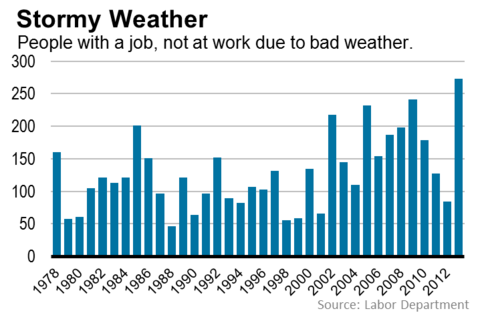Will the Bad Weather Last?
The US economy added the fewest number of jobs in December (74,000) since January 2011. [i] Much of the blame for the terrible jobs report was the weather. I know the weather was horrific in parts of the country. We have a national clientele and plenty of anecdotal evidence. According to Phil Izzo and Kathleen Madigan from the Wall Street Journal, some 273,000 people were not at work in December due to weather. [ii]

Unfortunately, there are two problems with this thinking. First, the 273,000 are counted as employed whether or not they had to miss work because of weather. It’s treated in the jobs number the same way as an employee taking a sick day or a vacation day.
Secondly, if you thought that adding the 273,000 number to the 74,000 jobs added would give you more clarity on how many new jobs we’d have without the weather, that would give you 347,000. To give perspective on that number, the average number of jobs added in 2012 was 183,000 per month and 192,000 in 2013 excluding the December report. A growth of 347,000 would be near double the average over the last two years. I just don’t see that as realistic.
The problem with the report
I’m not convinced that weather alone was the cause of the bad jobs report.
When you look at the industries that had a net loss of jobs in December, you do indeed see construction workers—which would be expected if you blame it on the weather. However, you also see job losses in the fields of computer and electronic products, motion picture, accounting and bookkeeping services, and health care. I don't associate these jobs tied to weather. [iii]

It's still too early to tell if there is a blemish developing in the economy or it's the same old "slow growth" we are accustomed to in the last 5 years. One thing is certain, which is that the headline unemployment rate is now rendered useless. Friday's labor report showed the unemployment rate dropping to 6.7%, just 0.2% above when the Fed said in the past that they would raise rates. We all know that's not likely to happen. The sole reason the unemployment rate dropped is associated with Americans dropping out of the job market. [iv]

We are now at the lowest point in American workforce participation in almost four decades.
While we will get a better picture of the jobs situation next month when weather isn't to blame the bad weather will likely persist when it comes to our workforce participation.
We continue to hold lower duration bonds, fundamentally strong equities, and a tilt toward non-US developed and emerging economies.
If you have questions or comments, please let us know as we always appreciate your feedback. You can get in touch with us via Twitter, Facebook, or you can email me directly. For additional information on this, please visit our website.
Tim Phillips, CEO – Phillips & Company
Alex Cook, Investment Analyst – Phillips & Company
[i] “All Employees: Total nonfarm (PAYEMS)”, Federal Reserve Economic Data
[ii] “Vital Signs: Mother Nature Keeps Workers at Home”, January 10, 2013, Wall Street Journal
[iii] “Table B-1. Employees on nonfarm payrolls by industry sector and selected industry detail”, US Bureau of Labor Statistics
[iv] “Civilian Labor Force Participation Rate”, Federal Reserve Economic Data